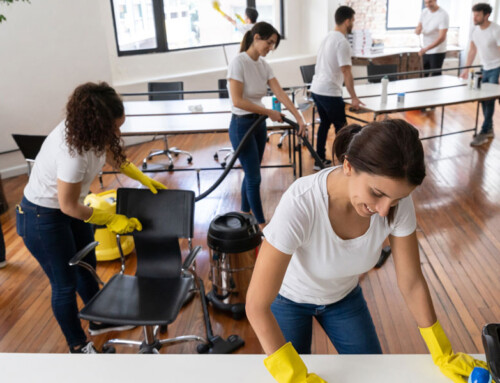Indoor Air Quality + Air Purification

Buildings and indoor spaces have been associated with the spread of infectious diseases through the air, such as measles, influenza, tuberculosis, Legionella, and COVID-19. People are often the source of infection, and your chances of being infected depend on the size of the room and the number of people in it. Just as you might think of a room full of smokers and the smoke they generate, you can also think of viruses and bacteria similarly being released into the air.
According to the Centers for Disease Control and Prevention (CDC), infectious diseases can spread when an infected person coughs, sneezes, talks, or breathes out droplets and tiny particles that contain viruses or bacteria. These droplets and particles can be breathed in by other people or land on their eyes, noses, or mouth. In addition, an infected person can contaminate surfaces they touch. Virus particles and bacteria in the air can settle on and contaminate surfaces. People can get infected by touching their eyes, nose, or mouth with hands that have the virus or bacteria on them.
A study from National Institutes of Health, CDC, University of California, Los Angeles, and Princeton University scientists in The New England Journal of Medicine found that severe acute respiratory syndrome coronavirus 2 (SARS-CoV-2) that causes COVID-19 was detectable in respiratory droplets in the air for up to three hours.
A single cough can expel more bacteria or viruses than a single breath. But if an infected person breathes 22,000 times per day while coughing up to 500 times, then coughing accounts for as little as 7% of the total bacteria or virus emitted by an infected patient.
What is ventilation rate and air change rate?
Knowing air quality terminology can help you ask the right questions when entering any indoor space.
Ventilation rate is the volume of outside air provided per unit of time.
Air change rate is the ventilation rate of a space divided by the volume of that space—the rate that outdoor air replaces indoor air.
ASHRAE, formerly called the American Society of Heating, Refrigerating, and Air-Conditioning Engineers, provides outside air ventilation standards for commercial buildings, including schools, hotels, convention centers, and airports. These minimum ventilation rates vary depending on the type of activity occurring in the room. Outdoor air dilutes contaminants produced by the occupants and the building itself, so rates are based on both the maximum number of people the room is designed to hold and the size of the room.
Ventilation air only benefits occupants if it reaches them. Therefore, we should consider the minimum ventilation rate within the “breathing zone.” ASHRAE defines the breathing zone as the region within an occupied space between three and six feet above the floor and more than two feet from walls or fixed air-conditioning equipment.
How much ventilation do I need in my home to improve indoor air quality?
ANSI/ASHRAE Standards 62.1 and 62.2 are the recognized standards for ventilation system design and acceptable indoor air quality (IAQ). Standard 62.1 Ventilation for Acceptable Indoor Air Quality outlines minimum ventilation rates based on the combination of cubic feet per minute (cfm) per person and per square foot of floor area, and both are related to the occupancy type. It includes three procedures for ventilation design (the Indoor Air Quality Procedure, the Ventilation Rate Procedure, and the Natural Ventilation Procedure) intended to provide indoor air quality that is acceptable to human occupants and that minimizes adverse health effects.
For example, museums/galleries require a minimum combined outdoor air rate of nine cfm/person, while animal areas in pet shops or weight rooms in health clubs require no less than 26 cfm/person. Office spaces require 17 cfm/person; however, an auditorium seating area only requires five cfm/person.
Standard 62.2 Ventilation and Acceptable Indoor Air Quality in Residential Buildings recommends that homes receive 0.35 air changes per hour, but not less than 15 cubic feet of air per minute (cfm) per person, as the minimum ventilation rates in residential buildings should provide indoor air quality that is acceptable to human occupants and that minimizes adverse health effects. With respect to engineering controls, an important flaw exists in that the current standards for ventilation are set for bare minimums and not designed for infection control.
What was the recommended ventilation rate before the COVID-19 pandemic for a classroom?
For a 1,000 square foot classroom designed for 35 people, including teachers and students ages nine and older, ASHRAE recommends a ventilation rate of 500 cubic feet per minute of outside air. This means there are 13 cubic feet per minute per person. If the ceiling height in the classroom is 10 feet, then the room needs three total outside air changes per hour. To calculate the number of air changes per hour, take the ventilation rate in cubic feet per minute and multiply by 60 minutes and divide by the room volume (length x width x height): (500 cfm x 60 minutes) / (10,000 ft3 ) = three air changes per hour.
What does reduced occupancy do to improve air quality?
One way to reduce the risk of disease transmission is to reduce the number of people in a room, reducing risk of close contact transmission. It also reduces the number of probable infections that will occur if there is an infected person in the room. And as an added benefit, more outside air is provided per person, contributing to better overall indoor air quality.
If we take the same classroom of 1,000 square feet and reduce the number of people from 35 to 17 by cutting the occupancy in half, the ventilation rate now provides twice as much outside air per person. The 1,000 square foot classroom with a 10 feet ceiling and a ventilation rate of 500 cubic feet per minute of outside air, for 17 people ages nine and older, we now have 26 cubic feet per minute/per person of outside air, and by still maintaining three air changes per hour.
Increasing ventilation with outside air has been proven to reduce the transmission of airborne diseases by lowering the concentration of infectious particles in the air. The reduced class size now allows space for social distancing. Wearing a mask over your nose and mouth that fits snugly against the sides of your face with no gaps also reduces the risk of infection and limits the number of particles released during breathing, talking, sneezing, or coughing.
Case study—tuberculosis outbreak at Taipei University in Taiwan
In a 2019 study of an outbreak of tuberculosis at Taipei University in Taiwan, rooms were under-ventilated with a rate of 3.6 cubic feet per minute/per person, and carbon dioxide levels were found to be in a range of 1,200 to 3,000 parts per million. Tuberculosis, like COVID-19, is an airborne disease. The university increased the ventilation rate to 51 cubic feet per minute/per person, resulting in carbon dioxide levels dropping to 600 parts per million, and the outbreak ended.
Costs
Increasing air change rates involves added costs of moving more air, as well as heating or cooling this larger volume of air. These added costs could be limited by using energy-efficient systems and “smart” systems that deliver air when the space is occupied. Natural ventilation (e.g., open windows) could minimize the costs of achieving increased ventilation.
The CDC’s website discussing Ventilation in Buildings lists a range of initial costs and operating costs, which, along with risk assessment factors—such as community incidence rates, facemask compliance expectations, and room occupant density—may affect the selection of tools. The following are examples of cost estimates for ventilation interventions:
- No cost: Opening windows, inspecting and maintaining dedicated exhaust ventilation, disabling demand-controlled ventilation (DCV) controls, and repositioning outdoor air dampers.
- Less than $100: Using fans to increase the effectiveness of open windows and repositioning supply/exhaust diffusers or fans to create directional airflow.
- $500 (approximately): Adding portable high-efficiency particulate absorbing (HEPA) fan/filter systems.
We need to keep the discussion going
Increasing air changes per hour is an important concept as an infection control strategy that could be deployed to help reduce risk within an indoor space from infectious diseases.
Reducing indoor respiratory aerosols is critical in reducing airborne transmission of infectious disease agents. It can be achieved through source control (well-fitted face masks, physical distancing, hand hygiene) and engineering controls (ventilation, filtration, ultraviolet germicidal irradiation). Air filtration and ultraviolet germicidal irradiation (UVGI) are also risk reduction options that were not discussed in this article.


















